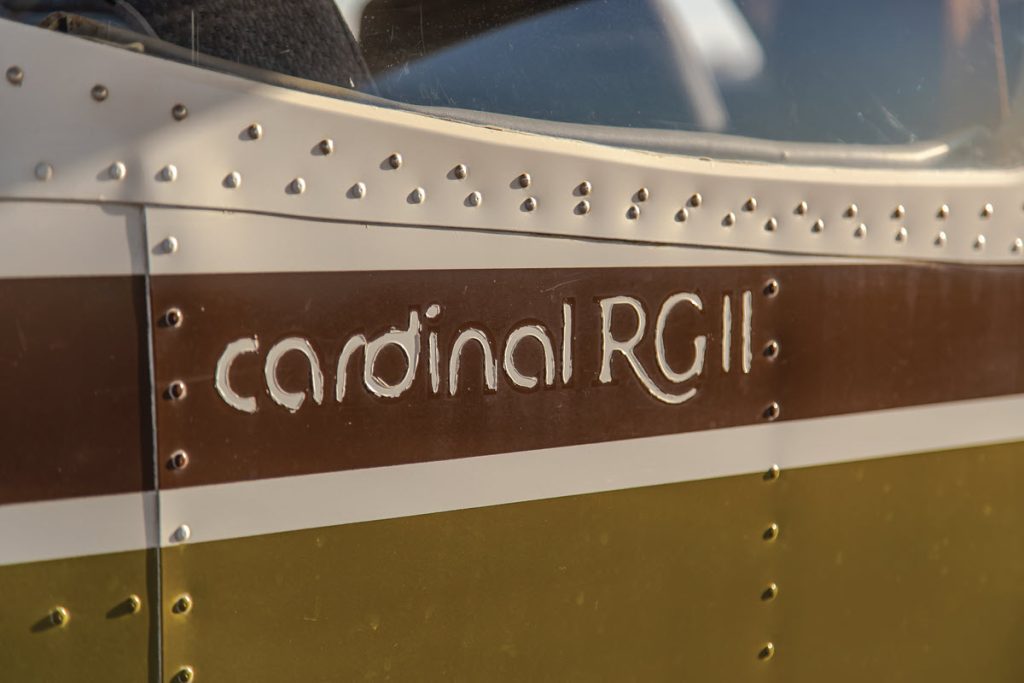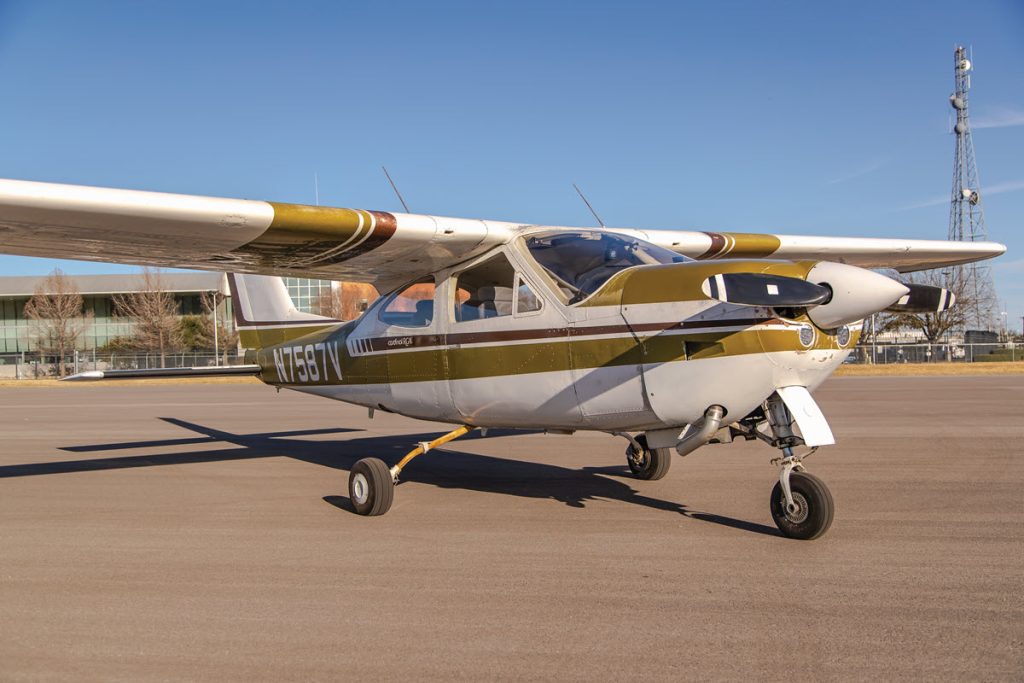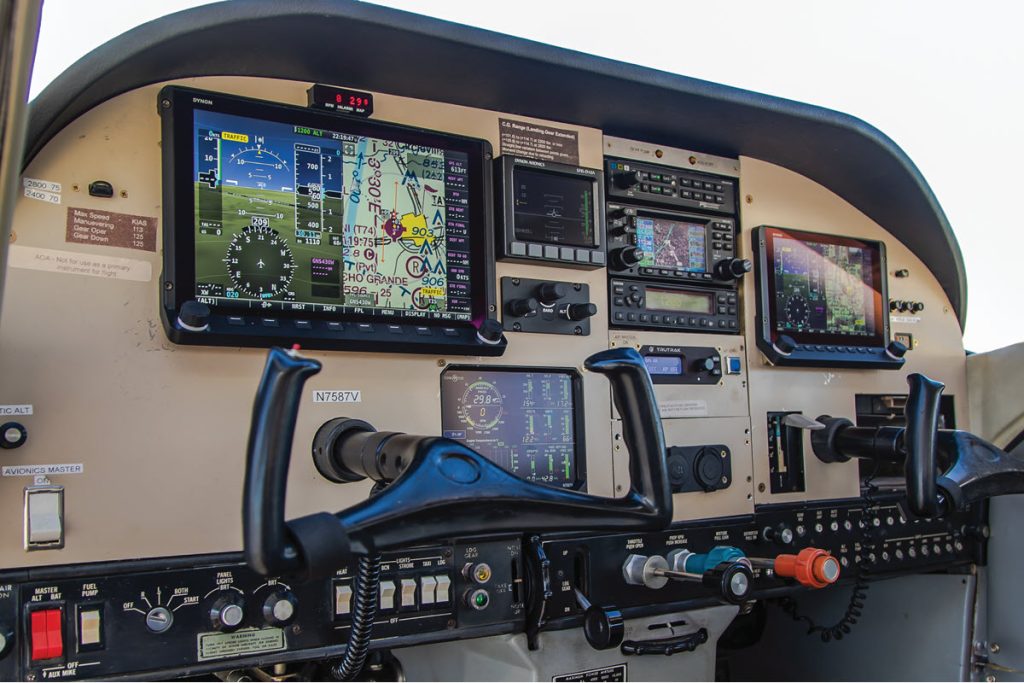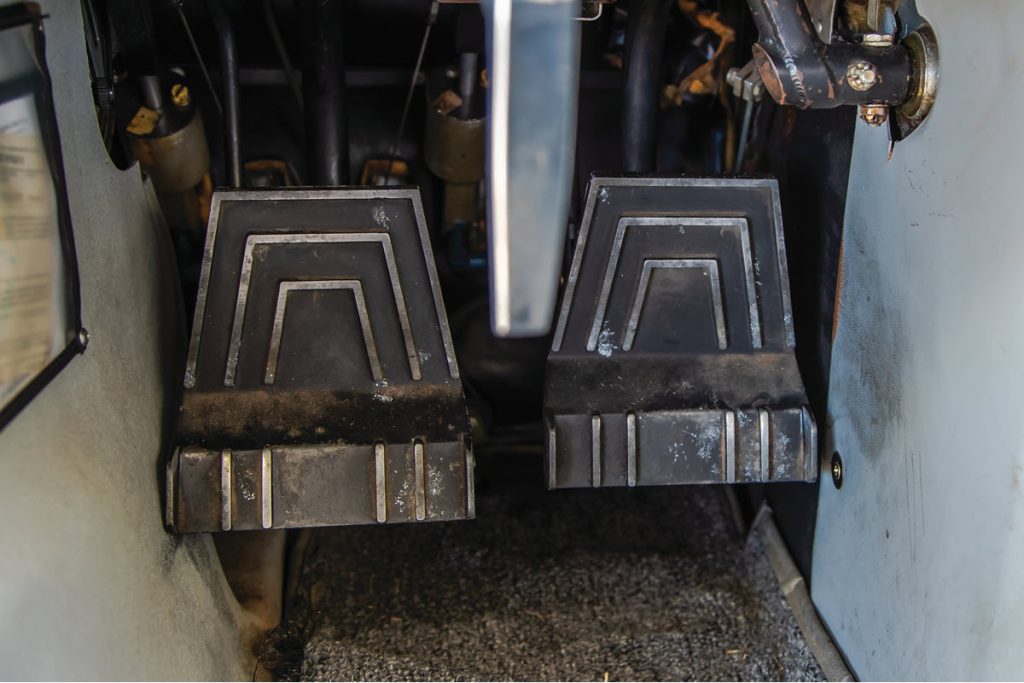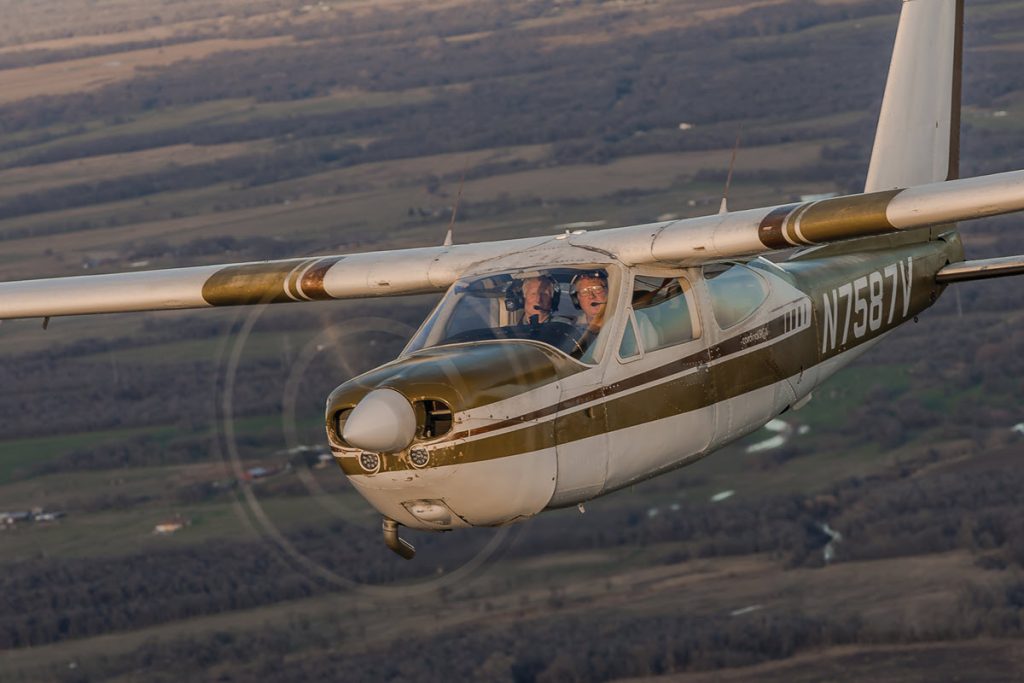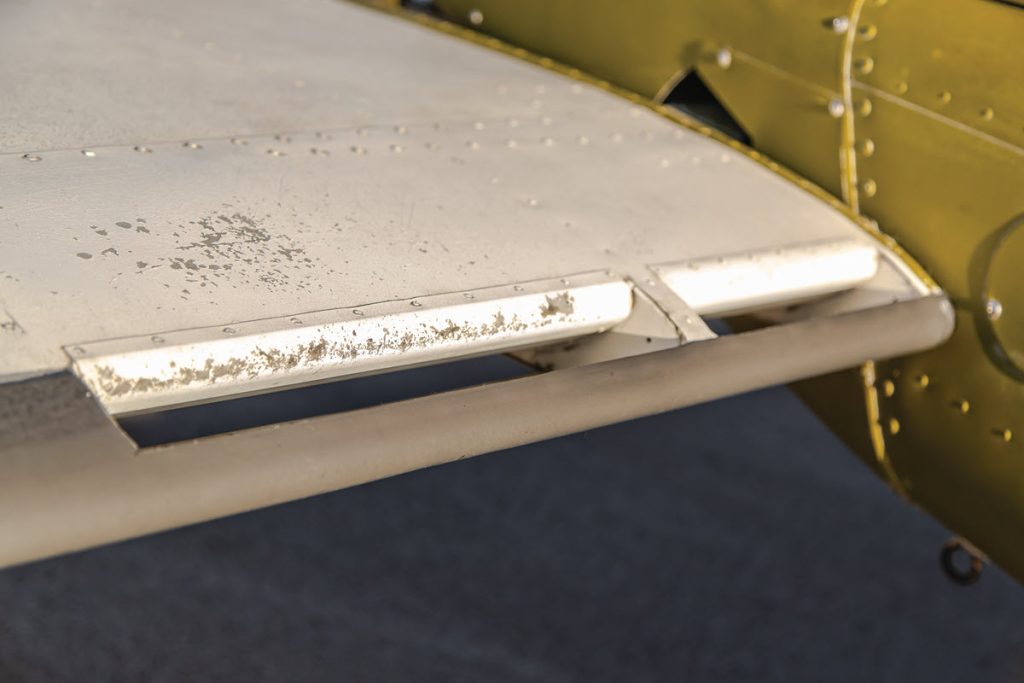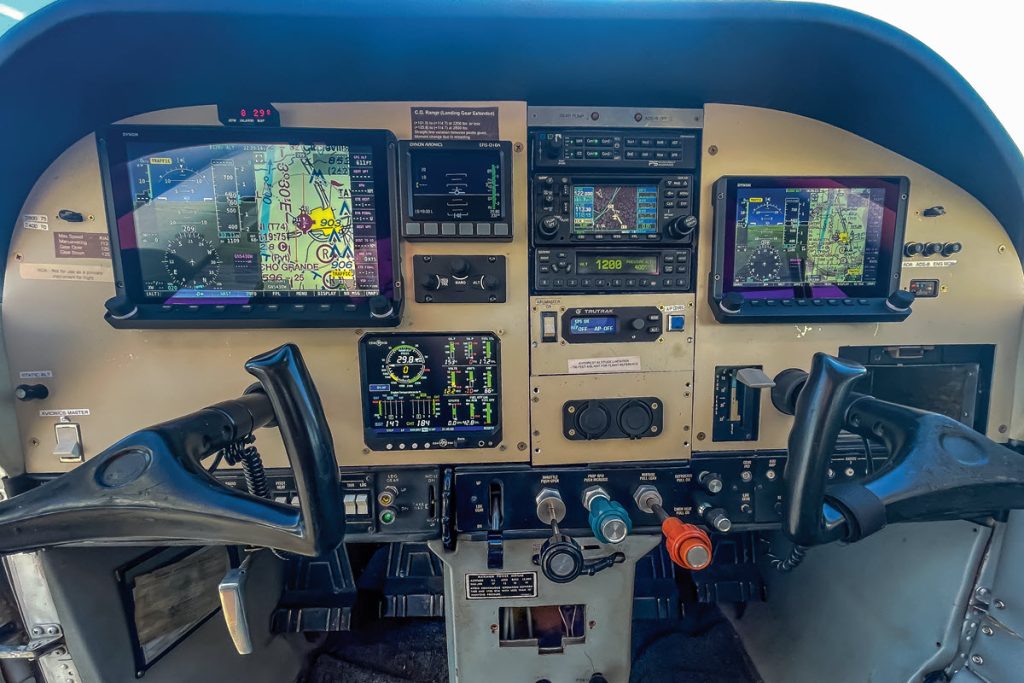
Eric Bradley’s Persistence and the Perfect Plane
By Dan Brownell
Although Eric Bradley has been around airplanes his entire life and had an ambition to be a pilot for three decades, he didn’t reach that milestone until several months ago. He faced a number of obstacles and delays along the way, but he finally achieved his goal in July 2022.
His adventure began in 1976 when his father, Vaynus Bradley, was stationed at Bergstrom Air Force Base in Austin, Texas, when Eric was 5. His dad flew the T-28, T-33, T-34, T-38, T-39, F-86, and the RF-4, a reconnaissance version of the legendary F-4 Phantom. During the Vietnam War, he flew 100 recon missions into North Vietnam in the RF-4 and has some hair-raising stories to tell.
Eric has vivid memories of his childhood at the base. “I recall going out to the runways with Dad and watching the airplanes take off and land. The noise, vibration, and sight of the planes was something I’ll never forget.” Eric’s brother, Vaylan Bradley, also served in the Air Force and flew the T-37, T-38, and F-16. He later flew in the Air Force Reserves as an instructor in the T-38. After he left active duty, he went to work for American Airlines flying the MD-80, the Boeing 777, and now the Airbus A319-A321.
Eric’s start in aviation was on the maintenance side, and even then, he got there indirectly. “As a kid, I was always fascinated by how things work,” he said. “I watched both my dad and brother work on cars and was always learning. When I got my first car, a 1970 Camaro which I still have, I did all my own work. After graduating high school, I worked at a race car parts business. While working there, I got involved in racing, which eventually led to me becoming involved with aviation.”
A casual conversation one evening started Eric on the long, circuitous path that led to him getting his PPL this past summer. “One night in the early ’90s, I was with some racing buddies, when Russell Stallings, a guy I had known for a while, asked me if I could help him out at the San Marcos airport, as he needed some help working on a plane. I assumed he just worked on planes, but he actually owned a plane modification business.
“I helped Russell out from time to time, and eventually he suggested that I get my A&P. I kind of laughed it off at first, but the idea stuck in my mind, and I decided to pursue it. I earned my A&P at Texas State Technical College, where Russell had attended. The last quarter I was there, I enrolled in the pilot training program to get my pilot certificate, but I didn’t complete it because the quarter ended before I was finished. I had been so close! I had taken the written and was even ready for the check ride. Little did I know at the time that it would be 30 years before I finally met my goal.”
Eric went to work as the sole A&P for a flight school right out of A&P training. He did that for a while but got burned out being on call 24/7, so he left aviation for the automotive industry. He earned his ASE Master Automobile Technician rating and has remained in the automotive industry since then. But Eric’s desire to become a pilot was still simmering in the background.
“In 2011, I decided I wanted to get back into aviation, purchase a plane, and finish my pilot certificate,” he said. “This would be the first plane anyone in our family has owned. When I told Dad about my plans, he said, ‘Whatever you plan on spending, double it, and we’ll go in halves.’ I agreed but told him he had to pick the plane. Dad said, ‘It has to be a high wing because I don’t want to sit in the sun, and it has to be retractable because real airplanes pick the gear up.’ That sounded good to me, and our search began. Dad investigated what was available in a high-wing retractable and found the Cessna 177RG. It carried a good amount of weight, had good interior room, and was very fuel efficient.
On the Hunt
The first plane Eric and his dad looked at was in Deep Creek, Maryland, and after an eight-hour pre-buy, they made an offer that the buyer accepted, and they shook on it. “We told him we would be back in a couple of weeks to do paperwork and pay for the plane. We offered to leave a deposit, but he said that wasn’t needed. A couple of weeks later, however, I called telling him when we were coming up, but he said that somebody had offered him more money and if I wanted to pay that amount, he would still sell it to us. I was — needless to say — upset at the news and told him that he could just keep the plane. Dad wasn’t happy either because, when you shake on something in Texas, that’s your word, and that’s everything.
About a month later, Eric’s father showed him a controller.com ad for a 1976 Cardinal RG in Santa Paula, California. The plane had been sitting for about six-and-a-half years but had a fresh annual. “As an A&P, it sounded to me like it could be a good buy, so we contacted the seller and off to California we went for a pre-buy inspection. I spent a full day looking at the airplane and didn’t find anything that made me want to pass on it. We worked out a deal with the owner and purchased the airplane in August 2011.
“I then spent four, four-day weekends at the Santa Paula airport going through the airplane, making it safe to fly. (Thanks to my brother for the airline tickets to travel there and back each time!) The detailed maintenance was important because the first trip was going to be halfway across the country to College Station, Texas, where I live.
“I ended up replacing or servicing a number of items. With all the maintenance done and the plane ready to fly, my dad, brother, and I planned to fly the plane back to Texas Dec. 27, 2011. (A huge thanks to my brother’s wife, Kathy, for allowing this because Dec. 27 is their anniversary.)
“At the time, the only person legal to fly was my brother, who had no Cardinal RG time and needed a checkout flight. I contacted CP Aviation at the Santa Paula airport and was able to find an instructor, Michael Phillips, who was available to give my brother a checkout on Dec. 26, the day after Christmas.
“As I watched my brother and Mr. Phillips taxi out to the runway, it dawned on me that I had never actually seen the plane fly yet. The plane became airborne, and a few seconds later the gear retracted. The first thing Dad said was, ‘Hey, the gear came up.’ My reply: ‘I’m more worried about it coming down.’ Then it disappeared into the distance.
“This was a nerve-wracking time for me, as I waited impatiently on the ground. To my relief, about an hour later, it came back into view. The best sight was the gear coming down on the downwind leg. They flew the pattern, and the plane landed with no problems. After filling in the logbook, my brother, dad, and I all hopped in and went flying for 45 minutes. It was a great flight, as this was the first time all three of us had been in a general aviation airplane together since the early ’80s.”
After landing, they topped off the plane with fuel and went to the hotel to get a good night’s sleep, as they planned on leaving at sunrise. They arrived at the airport the next morning, pre-flighted, and departed for the long trip home. Their first stop was Twentynine Palms, California (KTNP), then Casa Grande, Arizona (KCGZ), and finally Fort Stockton, Texas (KFST). They had selected those airports based on flying time, which would get longer after each stop, after checking the plane for any issues every time.
A Surprise Visit
At the Fort Stockton airport, they were refueling when four Texas DPS (Department of Public Safety) vehicles came from around the FBO building. “I wondered what they were doing. We quickly discovered that they were there for us. The officers came at us with weapons drawn and told us to move away from the aircraft. ‘What’s going on?’ I asked, completely baffled. The officer responded, ‘I don’t know. Homeland Security told us to detain your aircraft.’ Meanwhile, a Homeland Security officer was on his way from Alpine, Texas, to deal with whatever issue they thought we had. While waiting and talking to the officers, it became apparent to them that this was a misunderstanding and that we weren’t a threat, so two officers left.
“When the Homeland Security officer arrived, he asked for the plane’s registration, and when I handed it to him, he walked away and started talking on a cell phone. About 20 minutes later, he said, ‘I know what the issue is.’ The tail number you gave El Paso Approach wasn’t 7587V. It was 7857V.’ I explained that we had corrected El Paso Approach multiple times because they kept repeating it incorrectly. It turned out that N7857V was a 1976 Cessna Cardinal deregistered in 1983. Dad, my brother, and I had a good laugh over this, but the Homeland Security guy didn’t seem pleased. We finished fueling and headed to the hotel, still chuckling about the situation.”
The next day, they completed the final 2.5-hour leg to College Station, Texas (KCLL), where Eric lives. Soon after, Eric discovered that his dad had some 177RG Cardinal time from back in the ’80s at the Aero Club at Bergstrom AFB, and before long, his dad had a checkout flight on the plane.
“Meanwhile,” Eric said, “I worked on getting an instructor who would train me on the 177RG. The one I found wasn’t very motivated, and it took a long time to just get him to fly with me. But after I had two or three flights, I received my solo endorsement.
“With the instructor not being motivated and my not being able to fly consistently, I lost interest. I was flying with Dad a lot, so I at least got to fly. I enjoyed working on the airplane, and Dad and I had fun taking trips in it. But before I knew it, years had passed. Finally in July 2020, after everyone at the airport kept asking when I was going to finish my pilot’s certificate, I studied and passed the written again.”
Another Delay
Then COVID-19 hit and Eric wasn’t able to fly. “I had hit another obstacle in my flight training! It’s like it wasn’t meant to be. Then in late 2020, a CFI, Frank Fisher at KCFD, asked me if I would put a Dynon HDX System in his airplane, as I’m a Dynon authorized installer. I agreed on the condition that he would help me finish my pilot certificate. He was fine with that, so I was back on the training path. We flew together when timing worked out, but my work schedule was getting in the way. By July 2022, my written was about to expire at the end of the month.
“At that point, I didn’t care who I got mad at work. I was determined to finish by the end of July. We made sure I had everything completed, and I scheduled my check ride. I contacted Wanda Collins at KUTS in Huntsville. She said she would be available for a check ride sometime in early August, but when I explained that my written was going to expire at the end of July, she gave me a date of July 22. Great, I thought. It’s finally going to happen.”
| Engine | Lycoming IO-360-A1B6D |
| Horsepower | 200 |
| Top Speed | 180 mph (156 kts) |
| Cruise Speed | 170 mph (148 kts) |
| Cruise Speed (Economy) | 137 mph (119 kts) |
| Fuel Capacity | 61 gal |
| Range | 895 miles |
| Gross Weight | 2,800 lbs |
| Empty Weight | 1,707 lbs |
| Avg. Useful Load | 1,093 lbs |
| Takeoff Ground Roll | 890 ft |
| Takeoff Over 50 ft Obstacle | 1,585 ft |
| Landing Ground Roll | 730 ft |
| Landing Over 50 ft Obstacle | 1,350 ft |
| Rate of Climb | 925 fpm |
| Ceiling | 17,100 ft |
| Doors | 2 |
| Seats | 4 |
| Electrical | 14v |
| DIMENSIONS | |
| Cabin Width (at shoulder) | 42 in |
| Length (approx.) | 27 ft, 3 in |
| Height (approx.) | 8 ft, 7 in |
| Wingspan (approx.) | 35 ft, 6 in |
The Cardinal RG was produced from 1971 through 1978. These are the specs for a 1976 plane, but they are very similar through 1978. Every vintage airplane is different; do not use these specs to plan a flight. All data taken from the Standard Catalog of Cessna Single Engine Aircraft (JP Media LLC).
Mission Complete!
“I flew to KUTS on the appointed day. Wanda was great and I wasn’t nervous, but she was surprised when I pulled out a paper sectional chart rather than an iPad. But that’s what I had learned back in the day and what I was comfortable with. We finished the ground portion and went to fly. Upon landing, Wanda said, ‘Congratulations, all we need to do now is fill out your paperwork.’ When that was done, I climbed back into the 177RG and departed for KCFD. Not until I was about halfway back did it really hit me that I was now a pilot — an accomplishment made all the sweeter in that it had taken me 30 years to achieve!”
As of Feb. 1, 2023, Eric has flown about 150 hours, and his goal is to have at least 250 hours by July 22, 2023. He has already flown to Las Vegas and Indianapolis, and he’s planning on flying to the Cardinal Flyers Convention in Winter Haven, Florida, in March just before Sun ’n Fun. The airplane has about 3,200 hours total time and 2,200 on the engine. “We have flown the airplane about 750 hours total and have enjoyed every minute of it,” he said.
The 177RG: Perfect for Eric’s Mission
The 177RG has proven itself to be ideal for Eric’s purposes. “We use 87V for extended trips. We like going long distances to see what America has to offer. I’m not one to just take off and fly the pattern for 30 minutes and land. I think since I got my pilot certificate, I’ve only made about three or four flights that aren’t considered cross-county. I like to have a mission for a flight. It may be to fly to other airports to do a touch-and-go or get something to eat, but it’s something other than flying within 30 to 40 miles of home.”
The 177RG is well suited to this mission. “If I’m not in a hurry, at 9,500 feet, I’ll cruise at 144 kts TAS and 7.9 gph lean of peak. If I want to put power to it, I can do 156 kts true airspeed (TAS) at 10.2 gph. I did a nonstop leg from Casa Grande, Arizona (KCGZ), to Georgetown, Texas (KGTU), and burned 45 gallons of fuel. Having the 60-gallon tanks of the 177RG allows for some pretty long legs.
“The 177RG has great front visibility. You can lean forward and look up above the wing. This is great for visibility when turning. The large doors make it easy to get in and out. In our airplane, we never move the seats because my dad and I use the same seating position. This helps reduce seat track wear. The rear seat has ample leg room for a long trip, and the seat back is adjustable. The airplane has ample airflow inside the cabin due to the vent windows on the doors, four interior ball vents, and two vents on the side of the fuselage just behind the cowling letting in air. My airplane has articulated pilot and co-pilot seats that allow up/down, front/back, and seatback tilt.”
The Cardinal’s Carry-Through Spar AD
On Feb. 13, the FAA issued a carry-through spar airworthiness directive for the 177 Cardinal due to a Cessna 210 having a carry-through spar in-flight failure. The 2014-T6 aluminum forging material that is used for both airplanes is susceptible to corrosion. This has been a known issue in the Cessna 177 community for years, and diligent owners have been proactive in watching for this issue and addressing it immediately. This AD has been in the works for some time. A Cessna service letter was issued following the Cessna 210 in-flight carry-through spar failure to notify Cessna 177 owners of the possible issue and a procedure to check for it.
“I wouldn’t allow this AD to change my mind on buying a 177RG,” Eric said. “But I would make sure the AD has been complied with or that the plane is valued accordingly. Like all airplanes, some 177s just don’t get the love and attention they deserve.
“When we bought the airplane in 2011, at the first annual, I cleaned the carry-through spar and Alodined it for protection. If you’re looking to buy a Cardinal, I would highly recommend pulling the headliner and having an A&P look at the carry-through spar even if the service bulletin has been complied with, as it also gives you a chance to check the roof area for other corrosion. I would also advise getting a pre-buy done by someone who has Cardinal RG experience.
“The primary cause of the 177 carry-through spar corrosion is that the fresh-air ducts for the rear seat pass through the spar. The original ducts were fabric and held moisture. The wet duct rests on the carry-through spar, causing corrosion. This is a known issue and most Cardinal owners have replaced the fabric hose with silicone hose.
“A secondary cause of the corrosion is that the top of the spar is exposed to the roof of the aircraft. The front and rear skin attach to the edge of the spar, leaving about a 3-inch-wide portion exposed along the width of the fuselage. This isn’t a problem until the seam starts to leak, but many do develop the leak, as mine did. The leak allows moisture into the roof area and down onto the spar, soaking the insulation, which leads to corrosion. This is why the headliner should be removed to allow a thorough inspection.”
Cardinal Handling Characteristics
Pilots who transition into a Cardinal RG should be aware that the plane uses a significant amount of trim. “When taking off and retracting the gear, you’ll need to trim the nose down, and when slowing for landing, you’ll need a lot of nose-up trim. In fact, when I land, I’m usually right at full nose-up trim. The control forces get very high if you don’t trim. There’s a definite difference compared to a Cessna 152. A friend of mine, John Romero, who bought a 1972 177B fixed gear, told me after his first flight that this was great advice because he didn’t remember that much trimming in the 172.
“The best modification I’ve made for performance was adding the Power Flow Exhaust. The climb rate increase was very noticeable. In retrospect, this should have been my first mod after buying the airplane.”
A Labor of Love
Eric has invested a lot of time and money getting his plane to perfection. “I have done a lot of work on 87V since we purchased it in 2011. I have rerigged the landing gear, aligned the main gear, and installed new interior plastic, a new aluminum panel and stabilator brackets, treated corrosion under the right wing comm antenna, and removed the wings to check the carry-through spar and wing-spar bushings along with the wing pins.
“We’ve also done extensive upgrades including Dynon HDX displays, Garmin GTX 327 transponder, JPI EDM 930, PS Engineering PM6000B audio panel, Alpha Systems AOA, TruTrak autopilot, Power Flow Exhaust, Sky-Tec Starter, Plane-Power alternator and regulator, Whelen LED landing and taxi light, and Skybolt cowling fasteners.
“I have a few items that I plan on completing soon. I purchased a laser marking machine, and I plan on removing the instrument panel to laser mark all the labels so I can get rid of the stick-on labels. I am also going to replace the rest of the interior plastic for the lower door portion, door sill, kick panels, and center console. I also plan on adding a Dynon transponder and comm radio. In the long run, I would like to get the airplane painted, but first I want to finish everything that makes the plane even more enjoyable to fly.”

Cover Story
Eric and his father are the cover story for this issue, which echoes a story that goes back five decades. “Back in 1962, Dad and three other Air Force pilots picked up four brand-new T-38s to bring them back to Williams Air Force Base in Arizona,” Eric said. “During the flight, a Northrop photographer in one of the planes took photos of the formation. For years, Dad has had one of the framed black-and-white photos hanging on his wall. That original photo shows an empty rear seat in the plane, as it was a ferry flight, not a training flight. Someone later added a pilot in the back seat.
“After we bought 87V in 2011, Dad said we needed to subscribe to FLYING magazine because we now own a plane, so we did. Several years later, Dad was reading the September 2013 issue when he spotted the colorized version of that formation photo, with the added rear-seat pilot. That photo had been used on the FLYING magazine cover 50 years before. Dad was stunned to learn that his plane had been featured on the cover so many years ago — but he never knew. That’s special for me because I’ll get to be on the cover of Cessna Owner magazine, flying with Dad in our Cessna 177RG. I’ll be celebrating my first time on a magazine cover, and he’ll be celebrating his second.” A fitting conclusion to a story that’s been in the works for 50 years!
Select a photo to open a pop-up slide show.











